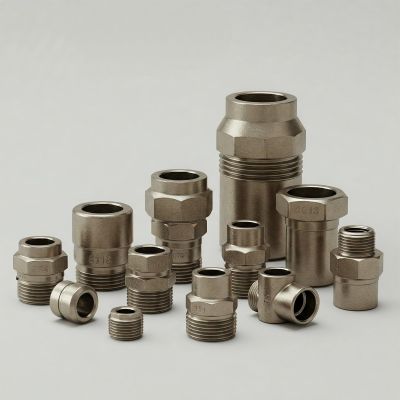Pipe threads play a crucial role in industrial applications, ensuring secure and leak-free connections in plumbing, gas, and hydraulic systems. However, confusion often arises between British Standard Pipe (BSP) threads and National Pipe Thread (NPT), as both are commonly used worldwide.
This guide will explain the key differences between BSP and NPT threads, their compatibility, and the best use cases to help you make informed decisions when selecting pipe fittings.
What Are British Pipe Threads (BSP)?
British Standard Pipe (BSP) threads are widely used in Europe, Asia, and other regions for connecting pipes and fittings. They are defined under standards such as ISO 7-1 (for tapered threads) and ISO 228 (for parallel threads).
Types of BSP Threads
1. BSPP (British Standard Pipe Parallel) – G Threads
➡️ Features parallel threads (constant diameter along the length).
➡️ Requires washers or O-rings for sealing.
➡️ Commonly used in low-pressure applications like plumbing and water systems.
2. BSPT (British Standard Pipe Tapered) – R Threads
➡️ Features tapered threads that gradually decrease in diameter.
➡️ Seals through thread interference, often without additional washers.
➡️ Used in high-pressure applications, including gas and hydraulic systems.
What Is NPT (National Pipe Thread)?
National Pipe Thread (NPT) is the standard thread type used in North America for pipe fittings. It is defined by ANSI/ASME B1.20.1 and is widely used in the United States and Canada.
Key Features of NPT Threads
➡️ Tapered thread design that allows sealing through thread interference.
➡️ Typically does not require O-rings or washers but may use PTFE tape or thread sealant to enhance sealing.
➡️ Commonly used in gas systems, plumbing, and hydraulic connections.
Key Differences Between BSP and NPT Threads
|
Feature |
BSP Threads |
NPT Threads |
|
Thread Angle |
55° Whitworth thread form |
60° thread form |
|
Taper vs. Parallel |
BSPT (R) is tapered, BSPP (G) is parallel |
NPT is tapered |
|
Sealing Mechanism |
BSPT seals via thread interference, BSPP requires washers/O-rings |
NPT seals via thread interference, often with PTFE tape |
|
Standard |
ISO 7-1 (BSPT), ISO 228 (BSPP) |
ANSI/ASME B1.20.1 |
|
Common Usage |
Europe, Asia, global applications |
North America |
|
Interchangeability |
Not directly interchangeable due to differences in angle and pitch |
Requires adapters for conversion |
Thread Pitch & Sizing Differences
➡️ BSP and NPT threads differ in thread pitch (number of threads per inch or mm), making them not directly interchangeable.
➡️ Using a thread pitch gauge is recommended to identify the correct type.
How to Identify BSP and NPT Threads
1. Measure Thread Diameter and Pitch
➡️ Use calipers to measure the outer diameter (OD) for male threads and inner diameter (ID) for female threads.
➡️ Use a thread pitch gauge to determine the pitch (threads per inch or mm).
2. Check Thread Angle and Depth
➡️ BSP threads have a 55° thread angle, while NPT threads have a 60° angle.
➡️ Inspect the thread depth and shape to confirm compatibility.
3. Use Standard Thread Charts
➡️ Compare your measurements with BSP and NPT thread charts for accurate identification.
BSP vs. NPT: Selection Guide
When to Use BSP vs. NPT Threads
➡️ Use BSP threads when working with European or Asian fittings.
➡️ Use NPT threads for North American systems.
Regional Preferences
➡️ BSP is commonly used in Europe, Asia, Australia, and international markets.
➡️ NPT is standard in North America.
Best Practices for Sealing
➡️ BSPT and NPT: Use PTFE tape or pipe sealant to ensure a tight seal.
➡️ BSPP: Always use washers or O-rings to prevent leaks.
Conclusion
Understanding the differences between BSP and NPT threads is essential for selecting the correct fittings and ensuring leak-free, secure connections. While BSP threads use a 55° Whitworth form and include both tapered and parallel types, NPT threads use a 60° taper for sealing without additional washers.
Key Takeaways:
-
BSP is used globally, while NPT is standard in North America.
-
BSPT and NPT are both tapered but differ in angle and pitch, making them not interchangeable.
-
Use proper measuring tools to identify and match threads correctly.
-
Sealing methods differ: BSPP requires O-rings, while BSPT and NPT rely on thread interference.
For the best results, always verify thread specifications, use proper sealing techniques, and choose the right standard for your application.
Post time: Feb-18-2025



